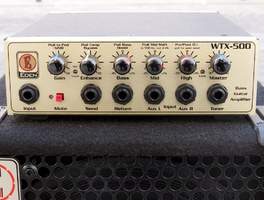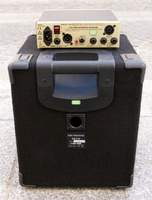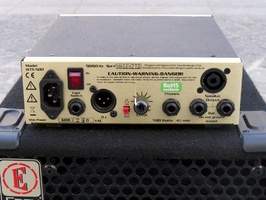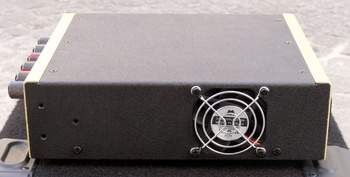When I was starting out as a bass player I didn't dream about the ideal amp. Of course, I fantasized about bass guitars but I can't remember being excited by a great combo or a bulky stack. For me, amplifiers were only useful tools: you had to plug into one to get a sound. And the most important thing was to have enough output volume, regardless of the sound quality. But the years and the road have taught me that in order to increase my skills as a musician I had to improve the most essential sense to make music: my hearing.
I realized very quickly that the price of the best sounding systems was not something I could afford. Among the most respected (and most expensive) were the David Eden amps. In those times, when the most powerful amp heads weighted about 40 lbs, they were too bulky to be rackable, and produced a very typical sound color, this American company introduced something similar to a UFO: the WT 300, better known as the “Traveler.”
15 years later, I’m pleased to review the WTX-5, the descendant of the original Traveler, and the RX110, a compact speaker cabinet.
Affordable High-End
Before founding his own company and specializing in PA systems, David Eden used to repair household electrical appliances. You might think he enjoys playing bass in his spare time but he is more interested in brass instruments! In fact, he plays tuba, trumpet and sax in several amateur bands. But he also spends a lot of time standing in front of a console, mixing bands whose bass players are his friends. Back in those days (mid 70's), amp manufacturers were not very kind to bass players. There were only a few stacks available that, technically speaking, didn’t change a lot compared to previous decades. In short, musicians looking for a new sound color, i.e. different from the typical 60's sound, were out of luck.
While listening to a friend play a Randall amp that produced the most awful sound he had ever heard before, David decided to help his friend out by building a new speaker cabinet. Then, with a good idea in mind about what should be a good bass amp, he started manufacturing his products in small quantity. He founded Eden Electronics in 1976 and manufactured his first line of stereo amp heads, as well as several speaker cabinets (2×12"), in 1978. But it was a risky bet: except for Alembic, very few manufacturers dealt with such concepts. As a consequence, there was a market segment to be conquered but nobody could guarantee the success of such a counter-trend.
But with the support of many professional musicians, the pioneer carried on in the same direction. The demands of bass players are simple, but also quite opposite to those of guitar players: a bass player wants an amp that faithfully amplifies his instrument and playing while adding warmth to the sound. Eden works to satisfy this demands by manufacturing custom stacks for professional musicians based on simple but innovative ideas and specifications taken from the military. High-quality components guarantee reliability, increased performance and modular design, making service and upgrades easier. The design of the speakers aim for a flat reproduction over a wide frequency range, a high power rating and a short response time for perfect transient reproduction. The goal of the designer is simple: reproducing the natural sound of a bass guitar depends on the attack much more than on resonance.
Eden amps distinguishes itself from other brands by producing a faithful and dynamic response. In this matter, Eden was among the first manufacturers to bet on 4×10" speaker cabinets, which are now well established and offered by all brands. Within a few years, the company became one of the leaders in the high-end market segment. To reach the lower market segment, the manufacturer created Nemesis but its sales didn’t quite meet the expectations. In 2002, the company was taken over by US Music Corporation, which allowed David to continue leading the brand. But in 2011 the founder, always faithful to the philosophy that made him successful, decided to create a new company (DNA: David Nordschow Amplification) and go back to elite products.
Never Compromise?
Let’s put the slogan of the brand to the test with the WTX 500, which is more affordable than the WT 550E, the manufacturer’s reference product. The price difference is not too big (about $100). At first sight there are a couple of details that do make a difference: the WTX 500 has no semi-parametric EQ and is “not signed” by David Eden, probably because he had already left the company when the product was conceived. And looking at the rear panel, you can read “Manufactured in China under stringent quality standards” — quite different from the traditional “Handcrafted in Montrose, USA.”
With less controls than its big brother, the WTX 500 has some pretty compact dimensions (8" × 2.5" × 9") and a reduced weight of about 4 lbs. The dimensions/weight ratio of this 4-ohm, 500-watt RMS amp is impressive. For more convenience, many connections (1/4" jacks) are available on the front panel: from instrument input to tuner output, FX loop and stereo Aux input. On the rear panel you have a DI out, a footswitch connector, a headphones out, and two types of speaker outputs (two 1/4" jacks and one Speakon). On the front panel you’ll find the following controls: input gain, enhancer, 3-band EQ, and master volume. From the six controls, five have a push-pull function (only the master volume is a standard potentiometer) allowing you to attenuate the input gain by 12 dB (for active bass guitars), to disable the auto-compressor, to boost the low-frequency range, to contour the sound, and to put the DI output signal before/after the EQ.
The speaker cabinet is a 4-ohm model but there is also an 8-ohm, 300-watt version available . I was not able to fully crank the amp head because it can deliver up to 500 watts. The very compact dimensions of the cabinet (12.6" × 14.2" × 14.2") are very comfortable for transportation. Imagine: 300 watts in a practice combo! It seems that the cabinet is built using massive wood (resonance and density), so this little screamer weights 24 lbs. I especially like the position of the single handle which is very convenient for transportation. On the other hand, I still don’t like carpets (under my feet or on an amp). The amp has rectangular bass-reflex ports across the front’s full width. The rear side provides only one 1/4" jack input (which was bad for me because I didn’t have the proper cable). So I had to go to Pigalle —the Parisian district for musicians— and spend some time in music shops and cafés with friends in order to be able to write this review. All the things I have to go through for my readers!
The quality of the components of the amp and the speaker cabinet is obvious. The front potentiometers of the WTX-500 feel great, reliable and accurate: a small turn is enough to feel the intrinsic quality of these components. The same applies to the reliability and durability of the housing, connections and switches. And once again, this also applies to the speaker cabinet, which has a very rugged construction (cabinet and grill) and is reinforced where necessary.
On the other hand, I have a remark to make: while the components seem to have a good quality, I cannot say the same about the assembly and finish. For instance, the eight plastic protection corners on the speaker: two of them were mounted askew. Luckily, this detail is only unpleasant for the eye but doesn’t affect the sound. Same thing for the head: the small color lines on all six front rotary knobs were not properly painted in their drills. The color leakage makes the amp look less superb.
Good. The overview is over and I have said everything I had to say about it.
Now, let’s go visit MUPSON Studios in the outskirts of Paris for a session with a good recording engineer.
Clubbing to Death
For this session, Marc Upson recorded my bass using both the DI out (direct recording) of the amp and a Neumann U87 in front of the speaker (miking). I was playing my Fender Precision Deluxe V and felt pretty comfortable. You’ll hear 16 takes (which means a total of 32 takes) presenting the EQ section, the contour filter and the enhancer in different playing styles.
First, I just twiddled with the EQ, starting flat and with several basic settings:

- 1. Neutre DI00:37
- 2. Neutre Mic00:37
- 3. Graves 3 med 3 aigus 0 DI00:37
- 4. Graves 3 med 3 aigus 0 Mic00:37
- 5. Grave 3 Med –3 Aigus 3 DI00:36
- 6. Grave 3 Med –3 Aigus 3 Mic00:36
- 7. Grave 4 Med 2 Aigus –2 DI00:36
- 8. Grave 4 Med 2 Aigus –2 Mic00:36
The EQ section is pretty effective. However, it’s a pity that the manufacturer didn’t integrate its semi-parametric EQ on this amp. The sweeping mids in Eden’s systems were always a reference EQ for me because of their efficiency and ease of use. But this is really a minor con that I just wanted to mention on my way to the next control. And I must add that some players don’t like such EQs, and paradoxically I can very easily do without. I just felt like complaining a bit…
Now, you’ll hear three enhancer settings: first off, then in center position and then fully on (the two last samples).

- 9. Enhancer 0 DI00:25
- 10. Enhancer 0 Mic00:25
- 11. Enhancer midi Di00:25
- 12. Enhancer midi Mic00:25
- 13. Enhancer fond DI00:26
- 14. Enhancer fond Mic00:26
Even if most users systematically use this knob, personally I don’t like it a lot because it affects the full frequency spectrum. However, during the review, I noticed that the different sound colors provided by the EQ could be positively emphasized by the enhancer. Personally, I like a mid setting to color the tone just a little bit. As a summary, this small control is more than a toy and might become necessary if the WTX-500 user knows how to handle it.
As everybody knows, the contour filter (also called “shape” or “mid-shift”) allows the user to quickly cut the mids in the frequency response. This time you just have to pull the Mid knob to put the mids on a serious diet. In order to try out extreme settings, I also enabled the bass boost for the last two samples.

- 15. Sans le contour general DI00:23
- 16. Sans le contour general Mic00:23
- 17. Bass Boost Med shift et Treeble Boost DI00:23
- 18. Bass Boost Med shift et Treeble Boost Mic00:23
Personally, I regret that I didn’t use both functions independently for some sample recordings. I like a tone with bass boost or with contoured mids, but I can’t stand using both at the same time. Thus, I think the two last examples are too extreme to give you a good idea of each function. However, I want to give you Marc Upson’s opinion, the guy who recorded the sessions, too. He finds these functions affects the DI output level a bit too much. I found an explanation for this when I read the user’s manual much later. Instead of a standard bass boost, the “bass boost” in the amp is conceived to ensure a good low-frequency reproduction at low output volumes. Thus, I guess that the gain is probably affected by the bass boost.
In order to check out the compressor, I used my favorite EQ setting. Since the compressor is fully automatic, it doesn’t have any controls: it’s either on or off. Following, you’ll find four examples from two takes: the first two samples are with the compressor off, the next two with the compressor on.

- 19. Compresseur Off DI00:16
- 20. Compresseur Off Mic00:16
- 21. Compresseur On DI00:16
- 22. Compresseur On Mic00:16
Don’t expect miracles from an integrated compressor, but at least you’ll hear how this one processes the signal. Certainly, we would welcome some (even limited) control, like a level knob for instance. But since the American Traveler 550 head doesn’t offer more features, I won’t carry on complaining.
And last but not least, here is a mishmash of sound samples with me doing some slapping and playing with a pick. For slapping, I recorded with two different settings: the first one is only with the EQ, the second one with the additional filters (bass boost and mid-shift). When playing with the pick, I played with the bass of the sound engineer (who is also a bass player and the studio manager, hence a nice guy). He owns a wonderful Lakland Precision bass with a kit of Franlin pickups and flatwound strings (the man has good taste).

- 23. Slap-egaliseur DI00:16
- 24. Slap-egaliseur Mic00:16
- 25. Slap-Contour DI00:17
- 26. Slap-Contour Mic00:17
- 27. Mediator PbLakland DI00:14
- 28. Mediator PbLakland Mic00:14
Conclusion
Personally, I’m quite excited by what I heard during this review. I find the amp reacts very well, is easy to use and very versatile. With its great dynamic response, the WTX-500 head can seduce any player. The 10" speaker does a good job considering its dimensions: it withstands the B-string of my bass, doesn’t produce uncontrolled sub-lows and reproduces very nicely the frequencies I want to hear. However, I guess this single speaker won’t be enough to play in a large venue. But for a club gig with a small band, the EX110 is both affordable and valuable. And I guess this stack will be of interest for double-bass players. In any case, I recommend them to give it a try considering the difficulties they already have transporting their instrument. To all bass player who want a bigger system for larger venues, I recommend the use of an additional speaker.
Or to choose another product within Eden’s wide speaker range. With a manufacturer committed to bass players for almost 35 years, you can be sure you’ll find the appropriate solution!





